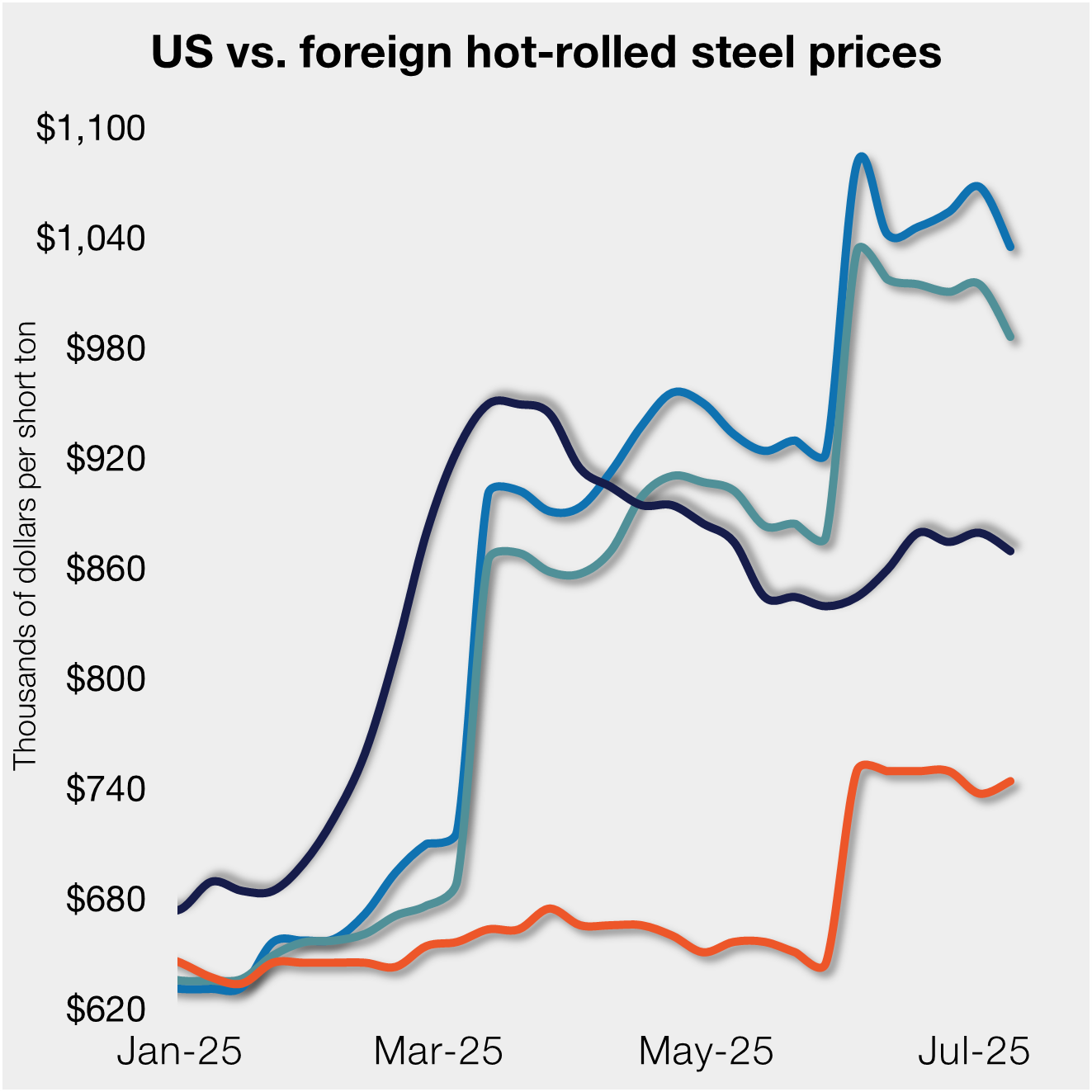International Steel Prices

CRU: Covid-19 Hits Steel Demand in Europe as China Starts to Recover
Written by Paul Butterworth
March 17, 2020
By CRU Research Manager Paul Butterworth, from CRU’s Global Steel Trade Service
Activity in steel end-use sectors in China is recovering as per CRU’s base case, but evidence suggests that demand may start to run ahead of our base case in the near term. Encouraged by government stimulus measures, there is a lot of optimism of a quick resumption of demand. However, the government will also be keen not to allow fresh outbreaks of the virus, which may lead to constraints on any improvement. So, although steel prices have returned to pre-CNY levels and steel production has been higher than our forecast, steel inventories are still increasing and there is a danger that downstream inventories may also increase if consumption does not return sufficiently fast. This may ultimately force steel prices to fall and yield a pullback in production.
Outlets for Chinese exports are diminishing day by day, as demand elsewhere is impacted by the virus and we are seeing more material available from Japan, South Korea and now India at increasingly competitive (i.e. lower) prices. The situation in Europe is worsening daily and, as conditions elsewhere in the world deteriorate with more countries move into some form of lockdown, the situation is certainly going to get worse.
Steel Demand is Improving Slightly More Rapidly Than Our Base Case
Passenger flows in China are still running at ~50 percent of normal, but people are returning to their province of work and the labor deficit in key manufacturing- and construction-intensive provinces has improved to ~23 percent compared with 30 percent last week. Coal consumption at large power plants, which is a good indicator of manufacturing activity, is at 85 percent of normal. Our understanding is that ~60 percent of construction projects have restarted. Additionally, the Ministry of Housing has said that 58 percent of housing projects had restarted. These measures of construction activity and proxy measures of manufacturing activity remain in line with our base case scenario for the recovery of demand.
Although Uncertainty Remains High…
While there are indications that the demand recovery might start to outpace our base case view, our China team is quick to point out that huge uncertainties remain. For example, we have seen specific uplifts to activity in the auto and domestic appliance sectors, but there is a risk this may simply lead to a build-up of inventory as consumption will remain subdued. This could put constraints on activity further down the line.
…Steel Prices Have Been Boosted by Expectations for a Quick Recovery of Demand
Steel prices are back to levels before CNY and have exceeded most people’s expectations, and this may be one factor supporting steel production (n.b. see further on). Indeed, from our contacts, we sense there is widespread expectation of a quick recovery in demand, supported by government action to prop up the economy. In this regard, there has been some stimulus for construction, infrastructure and road building. The central bank has provided RMB950 bn of new special bond issuances for infrastructure and cities have relaxed requirements for real estate developments to encourage new projects to start earlier. The central bank has injected liquidity into the financial markets through lower interest rates and, more recently, a reduction to the RRR (n.b. this latter action releases $76 bn into the financial system). Additionally, we have included an expected, further 20 b.p. interest rate cut in our short-term forecast. These actions by the government have encouraged optimism for a recovery and many now expect a short-term boost to demand. However, to put the new bond issuances into context, there were special bond issuances of RMB800 bn in each of the last two years; so, this issuance is not particularly excessive in our view.
Chinese Steel Production Has Remained Higher Than Expected…
Over the last three weeks, steel production has been higher than our forecast and we now estimate that instead of falling by 37 Mt over H1 (i.e. 30 Mt BOF, 7 Mt EAF), current figures suggest the fall in steel production could be lower, perhaps by 3 Mt, at around 34 Mt. However, again, there remain large uncertainties and the current divergence from our base case may simply be a timing issue. That is, steel production has, so far, exceeded expectations, but demand, although growing, remains muted and inventories have continued to build to very high levels. Thus, there is a high chance that inventory pressure, both of steel and downstream manufactured products, might ultimately put pressure on steel prices and bring production down again, particularly if any demand boost underwhelms people’s current expectations. In addition, our steel production forecast assumed an increase in steel exports from China of 12 Mt during H1, but this forecast was made prior to the increase in Covid-19 cases outside China and the consequent declaration of “pandemic” status by the WHO.
…Despite Dwindling Export Opportunities
Outlets for exported material are rapidly diminishing, as economies elsewhere feel the impacts of the virus, and our export forecast looks increasingly optimistic, particularly in the face of a more aggressive export stance from countries such as Japan, South Korea and, more recently, India, that itself may be feeling the effects of lower buying interest from Italy (see below).
What About Elsewhere? Europe Now the Epicenter…
Covid-19 infections are now escalating elsewhere and more European countries are moving towards national lockdowns that place restrictions on movements. In Europe, the situation has moved most quickly in Italy where, after initially maintaining activity, including truck deliveries of raw materials and steel products, deliveries are now an issue and concerns are heightened.
…and Manufacturing Activity is Slowing Sharply
The focus up to this week has been in Italy. However, over the last day, there have been announcements of temporary manufacturing closures across the rest of Europe.
PSA group has announced the closure of all its automotive production plants in Europe and VW looks set to follow in Germany. Manufacturers further down the automotive supply chain like Michelin are also suspending activity. Fiat has announced that it will close eight plants: six in Italy, one each in Serbia and Poland. The Italian construction association (ANCE) has asked the government for powers to close construction sites. Fincantieri, a large shipbuilder, has suspended operation of its shipyards in Italy for two weeks from Monday, March 16. Consequently, several Italian steel plants are shutting capacity, particularly in the north. A strike is underway at Taranto, with 8,000 employees walking out saying the company is not protecting its workers. The company has announced that it will temporarily shut down a blast furnace (n.b. #2), a steel shop and rolling mill at the plant.
Buyers Focused on Securing Longer Lead-Time Niche Products
Steel buyers in Europe appear relaxed about the availability of commodity grades, but there is some additional buying of more niche grades, as buyers stock up in expectation of further disruption. However, overall, we are not seeing much impact on the steel market outside Italy at this time. More companies are undergoing the stress testing of working from home, where possible, and force majeure implications are being increasingly discussed. The European market for pellet is doing relatively well now, with strong demand, but it is recognized by those in the market that this may change.
The evolution of Covid-19 in Europe is moving at a pace and conditions may change daily. So far, the effects in the U.S. steel market appear limited, but we do not believe this will remain the case for long.
Paul Butterworth
Read more from Paul ButterworthLatest in International Steel Prices

S232 tariffs keep US HR prices below imports from EU
Hot-rolled (HR) coil prices in the US ticked down this week but have fluctuated little over the past month. Stateside tags continue to trail imports from Europe, supported by Section 232 steel tariffs that were doubled in early June.

Doubled S232 tariff holds US HR prices below EU
David Schollaert presents this week's analysis of hot-rolled coil prices, foreign vs. domestic.

Higher US CR prices inch closer to EU, Japanese tags
US cold-rolled (CR) coil prices continued to tick higher this week, while offshore markets were mixed.

Stacked S232 keeps US HR prices below EU
US hot-rolled coil prices crept up again this week but still trail imports from Europe.

Doubled S232 lifts EU, Japanese CR prices over US tags
US cold-rolled (CR) coil prices edged up again this week, and most offshore markets moved in the opposite direction. But the diverging price moves stateside vs. abroad did little to impact pricing trends. The bigger impact was from Section 232, which were doubled to 50% as of June 3. The higher tariffs have resulted in […]
